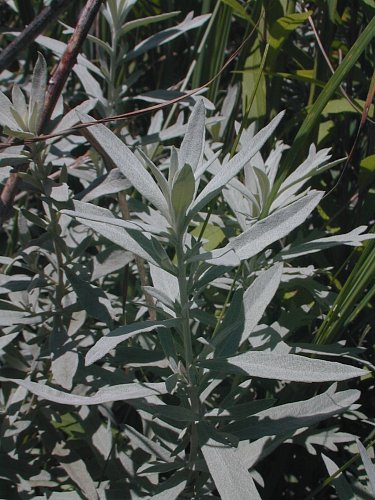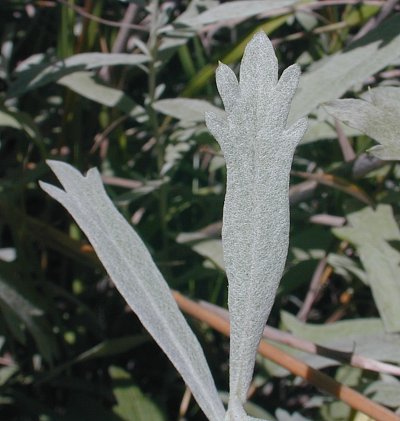Description: This perennial plant becomes about 2-3' tall when it is mature, branching occasionally in the upper half. The stems are covered in a dense mat of short white hairs. The alternate leaves are up to 3½" long and 1" across. They are usually oblanceolate, narrowly ovate, or linear. The lower leaves may have a few lobes or coarse teeth towards their tips, while the upper leaves have smooth margins. Like the stems, the leaves have a dense mat of short white hairs, especially on the lower surface. This variety of White Sage has dense white hairs on the upper surface of the leaves as well, except for the oldest leaves toward the bottom of the plant. The leaves are sessile against the stem, or have short petioles. Some of the upper stems terminate in elongated spikes or narrow racemes of compound flowers. Each flowerhead is only 1/8" (3 mm.) across, and contains numerous whitish green disk florets that are inconspicuous. The blooming period is late summer to early fall, and lasts about 2-3 weeks. There is no floral scent, although the foliage of this plant is quite aromatic. Pollination is by wind, rather than insects. The tiny seeds are without tufts of hair, but are small enough to be distributed by the wind. The root system is rhizomatous, and can form a dense mat of roots near the surface of the ground. As a result, this plant has a strong tendency to form clonal colonies that exclude other plants.

Cultivation:
The
preference is full sun and dry conditions. Poor soil containing hardpan
clay, rocky material, or sand is actually preferred as a medium for
growth, as this reduces competition from other plants. The foliage is
very attractive and doesn't have significant problems with disease.
This plant can spread aggressively in some situations.
Range & Habitat:
White Sage is occasional in northern and western Illinois, but rare or
absent in other parts of the state (see Distribution
Map). Some authorities think this plant is native to Illinois
(e.g., Britton & Brown), while others believe it is adventive
from the west (e.g., Mohlenbrock). It is usually found along railroads
and roadsides, and sometimes in dry upland areas of prairies.
Cultivated forms of this plant can be found in flower gardens because
of the attractive foliage. If this plant is native, Illinois would be
at the eastern boundary of its distribution.
Faunal Associations:
The flowers don't attract many insects because they are wind-pollinated.
White Sage has the potential to cause allergies in humans because of
this pollen, but this species isn't very common within the state.
Several grasshopper species feed on the foliage of White Sage (see Grasshopper
Table), including an uncommon oligolectic grasshopper, Hypochlora
alba (Cudweed Grasshopper), which often hides in the
foliage during the day. Other insect feeders include Ophraella
artemisiae
(Leaf Beetle sp.), Macrosiphoniella ludovicianae
(Aphid sp.), and the larvae of Phaneta argenticostana
(Tortricid Moth sp.); the moth larvae feed on the seedheads. Mammalian
herbivores don't consume this plant because the aromatic foliage has a
bitter taste. The seeds are too small to be of much interest to birds.

Photographic
Location:
The photographs were taken at Meadowbrook Park in Urbana, Illinois,
where a small colony of plants was located in a restored prairie. The
plants were not in bloom.
Comments:
This variety of White Sage has striking foliage. The typical variety, Artemisia
ludoviciana ludoviciana, has greener foliage with fewer white
hairs. The leaves of this latter variety are supposed to be broader and
more likely to have lobes or serrated margins toward the leaf tips.
However, the hairiness and shape of the leaves can be rather variable
for this species, regardless of the variety. Other Artemisia
spp. have foliage that is more green and pinnately lobed. A
few species, such as the introduced Artemisia vulgaris
(Mugwort), have silvery hairs on the lower surface of the leaves, but
their upper surface is predominantly green.